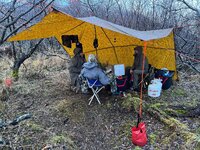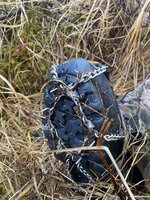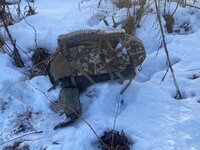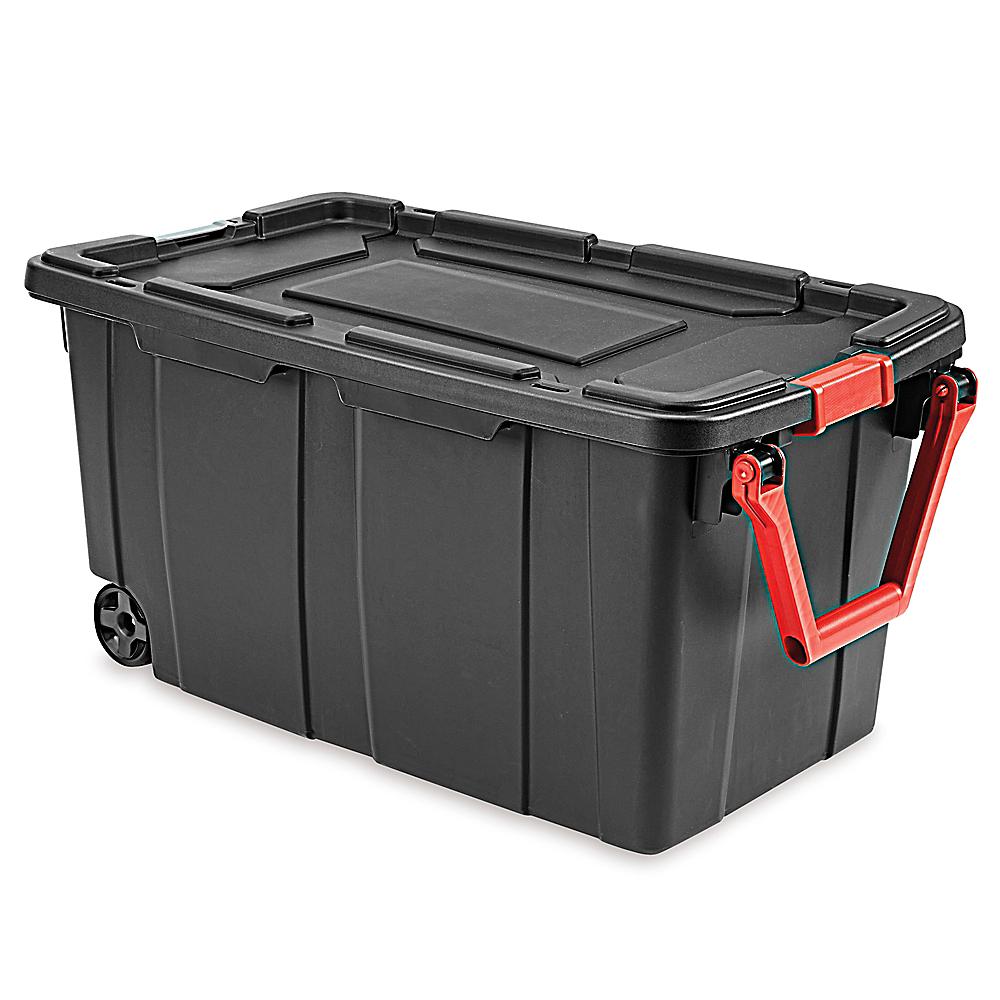mcseal2
WKR
- Joined
- May 8, 2014
- Messages
- 2,761
This thread is my attempt to pay back all the help and advice I received from guys here when planning my hunt. I owe you guys that helped me a lot, its priceless being able to ask questions when planning a trip like this. My midwestern home is a long way from the places I've hunted moose, caribou, and now deer in Alaska. Having a successful unguided hunt into these areas depends a lot on distance learning!
I'm not going to tell the story of our hunt here, I have an article on this hunt that will come out here sometime in January. A link to the article will be added to this thread and vice versa. Please ask any questions about the article here as well as any this thread generates.
***Update 1/7/2023*** Kodiak Blacktail Hunt Article
For the background of our trip we hunted with Island Air in November. Weather was a challenge, and we lost some hunting days due to it. We've been lucky on past trips actually gaining a day on our caribou and moose hunts. We showed up a day ahead of schedule organized and prepared for those hunts and were lucky enough to get out early. We were bound to get caught by AK weather at some point and this trip was it. It was nothing unexpected, it's just a part of hunting Alaska. I'll leave it there until the article comes out.
We chose to bring all our own gear again this trip. We had 4 guys and chose to rent a Beaver and a 206 to fly us and our stuff with. We had more weight allowance than we needed and chose to pack pretty heavy. If you can swing it a more comfortable camp is nice in a place that wet. Daylight hours are also much shorter than most hunts, so we took more regular food and a more elaborate kitchen than we usually would. I thank the guys who gave me this advice again!
Temps ranged from the upper 30's to upper 20's on our trip. We got home the 16th of November for some time reference. It was a wet cold the whole time. Even when it wasn't raining the air was damp, and with the wind it felt colder than the temps indicate. This cold is nothing like the dry cold I've typically experienced in Wyoming the end of elk season for example. I recommend packing like you would for 0 degrees in Colorado or Wyoming.
On to gear:
One of the biggest pieces of gear I appreciated on this trip was the Katoula microspikes for my boots. They are an absolute game changer in wet, slick, frozen, and muddy terrain. Once I tried them I used them the rest of the trip. They just gave me a ton of confidence stepping on a wet fallen alder, steep muddy bank, anything. I very highly recommend them. The last day I loaned them to one of my friends I was with and he felt the same way.
Trekking poles were useful but opportunity to use them is more limited than on other hunts. There was just so much weaving through thick alders that required both hands, one for the rifle and one to grab or move alders. The spikes made up for not being able to use the poles for the most part.
For clothing layers I took more than usual due to the weight allowance. Even when it wasn't raining the brush was all wet enough I wore rain pants the entire time. I did not even bother taking softshell pants. I wore my rain jacket the majority of the time as well sometimes with just a base layer underneath when hiking hard and the pit zips open. I highly recommend a rain jacket and pants with ventilation built in.
My clothing is a little of everything depending on what was on sale or what pieces I liked from different companies. They all have to get along in my system.
My standard layers each day were:
FL Wick hoody
Kuiu 240 hoody (often in pack)
FL Uncompaghre vest (often in pack)
FL Ridgeline QZ windbreaker (often in pack)
FL SEAK rain jacket
FL aerowool boxers
Darn Tough tall full cushion boot socks
FL aerowool 150 merino base layer
Kuiu Yukon rain pants
Kennetrek gaiters and Mountain Extreme boots
I used the Kuiu guide gloves if I needed a leather palm, or some of their older peloton gloves when I did not.
In the pack full time were a Kuiu Superdown Pro jacket and Ultra pants. Also Kuiu glassing mittens and spare peloton gloves. I used a Exo K2 3500 with the dry bag liner. This worked very well.
For use around camp I had FL Uncompaghre puffy pants and oversize Kuiu Chugach rain pants to fit over them. I had a Sitka Kodiak rain jacket also for back-up or camp use. I also had a Kuiu Kutana hybrid insulated shirt. I figure the shirt and vest give me a synthetic layering option to supplement or replace the down if I get it soaked. I've never had an issue with wetting out the Kuiu down stuff, but I've been pretty careful to keep it dry also. It was cold sitting under the cook tarp in the evenings, I was glad to have the extra layers. I also bought a warm fleece beanie hat at Big Rays in Kodiak I wore around camp or sleeping that was nice to have. I didn't realize I left my Kuiu one at home until we were in AK.
For boots I took my Kennetrek Mountain Extremes and my Crispi Hiland Pro boots. I used the Kennetreks the whole time, I never needed to switch to the Crispi's. There was much less standing water to cross than on my caribou hunt when I used the Crispi boots non stop. Leather boots and gaiters, plus Wiggys waders to cross creeks, were fine. I did treat my Kennetrek boots multiple times before the trip with waterproofing wax. I'd done it until they would absorb no more.
We hunted in pairs and one of us had a spotter and tripod, the other had a tarp and stakes. We carried Seek Outside DST tarps. People pack their fears and I'm no exception. I feel a lot better about spending a night out if I have a tarp to get under, and it's a very useful piece of gear for other things too. I have a lot of tarps or poncho/tarps and almost always have one in my pack depending on conditions. Alaska is a place I want a really good one. I actually carried my Kifaru sheep tarp in my pack the whole hunt in addition to the DST my hunting partner had.
Each pair also carried an In Reach and a trauma medical kit. Each had a tourniquet, quick clot, and a compression bandage. This was in addition to the normal stuff like Leukotape, bandaids, etc. I can share more detail on our medical and emergency gear if anyone is interested. With Kodiak's steep, challenging terrain, and the risk of bears we carried a little more than we do on some hunts. There is just more risk of injury and weather may prevent anyone from flying in to help. At camp I had a BEARFAK kit from Refuge Medical that was a step more complete trauma kit than what we had in our packs.
For guns 3 of us had 300 win mags, one guy had a 7mm Rem Mag. We all shot tough bullets through them, E tips or Accubonds. Jeff had a standard Remington 700 he borrowed from Dean with a duplex 3.5-10x scope. The rest of us all had scopes we could dial for elevation. I used my Rifles Inc 300 win mag built off a Winchester M70 classic action with the 180gr E tip at 2900fps. I love that rifle for Alaska as it's stainless and cerakoted. It has a 4-16x Huskemaw scope. Dean and Steve's rifles were built by Flint Hills Gun Works and had Swaro Z5 3.5-18x scopes. John at Flint Hills built my 264 win mag deer/antelope rifle as well. When we got home I sent my 300 to John and had him tear it completely down and clean it. I didn't want to take any chances with the salt air.
For bear protection we had handguns as well. I had a Sig 220 Hunter 10mm, Steve had a Springfield 1911 10mm, Dean had a Glock 20 10mm, and Jeff had his S&W 686 in 357. They were not needed but were nice to have. I like the 10mm's with a rail and light for doing chores around camp or packing meat in the dark. When I can I'll strap my rifle to my pack leaving it slower to access. Kodiak does not leave a lot of opportunity to strap the rifle to the pack with all the brush so the pistol is probably less necessary than some places, at least where we were. Still I was glad to have the pistol along. My Sig 220 is a heavy sucker, but I shoot it really well and it has handled every type of heavy ammo without ever having an issue. The only thing that makes it malfunction ever is light loaded 170gr practice ammo. I carry Underwood 200gr Hardcast in my Sig. Dean and Steve used Buffalo Bore 190gr all copper DG ammo. Dean bought my Glock 20 and it feeds that ammo perfect, it was never perfect with any lead hardcast I tried.
I'm not going to tell the story of our hunt here, I have an article on this hunt that will come out here sometime in January. A link to the article will be added to this thread and vice versa. Please ask any questions about the article here as well as any this thread generates.
***Update 1/7/2023*** Kodiak Blacktail Hunt Article
For the background of our trip we hunted with Island Air in November. Weather was a challenge, and we lost some hunting days due to it. We've been lucky on past trips actually gaining a day on our caribou and moose hunts. We showed up a day ahead of schedule organized and prepared for those hunts and were lucky enough to get out early. We were bound to get caught by AK weather at some point and this trip was it. It was nothing unexpected, it's just a part of hunting Alaska. I'll leave it there until the article comes out.
We chose to bring all our own gear again this trip. We had 4 guys and chose to rent a Beaver and a 206 to fly us and our stuff with. We had more weight allowance than we needed and chose to pack pretty heavy. If you can swing it a more comfortable camp is nice in a place that wet. Daylight hours are also much shorter than most hunts, so we took more regular food and a more elaborate kitchen than we usually would. I thank the guys who gave me this advice again!
Temps ranged from the upper 30's to upper 20's on our trip. We got home the 16th of November for some time reference. It was a wet cold the whole time. Even when it wasn't raining the air was damp, and with the wind it felt colder than the temps indicate. This cold is nothing like the dry cold I've typically experienced in Wyoming the end of elk season for example. I recommend packing like you would for 0 degrees in Colorado or Wyoming.
On to gear:
One of the biggest pieces of gear I appreciated on this trip was the Katoula microspikes for my boots. They are an absolute game changer in wet, slick, frozen, and muddy terrain. Once I tried them I used them the rest of the trip. They just gave me a ton of confidence stepping on a wet fallen alder, steep muddy bank, anything. I very highly recommend them. The last day I loaned them to one of my friends I was with and he felt the same way.
Trekking poles were useful but opportunity to use them is more limited than on other hunts. There was just so much weaving through thick alders that required both hands, one for the rifle and one to grab or move alders. The spikes made up for not being able to use the poles for the most part.
For clothing layers I took more than usual due to the weight allowance. Even when it wasn't raining the brush was all wet enough I wore rain pants the entire time. I did not even bother taking softshell pants. I wore my rain jacket the majority of the time as well sometimes with just a base layer underneath when hiking hard and the pit zips open. I highly recommend a rain jacket and pants with ventilation built in.
My clothing is a little of everything depending on what was on sale or what pieces I liked from different companies. They all have to get along in my system.
My standard layers each day were:
FL Wick hoody
Kuiu 240 hoody (often in pack)
FL Uncompaghre vest (often in pack)
FL Ridgeline QZ windbreaker (often in pack)
FL SEAK rain jacket
FL aerowool boxers
Darn Tough tall full cushion boot socks
FL aerowool 150 merino base layer
Kuiu Yukon rain pants
Kennetrek gaiters and Mountain Extreme boots
I used the Kuiu guide gloves if I needed a leather palm, or some of their older peloton gloves when I did not.
In the pack full time were a Kuiu Superdown Pro jacket and Ultra pants. Also Kuiu glassing mittens and spare peloton gloves. I used a Exo K2 3500 with the dry bag liner. This worked very well.
For use around camp I had FL Uncompaghre puffy pants and oversize Kuiu Chugach rain pants to fit over them. I had a Sitka Kodiak rain jacket also for back-up or camp use. I also had a Kuiu Kutana hybrid insulated shirt. I figure the shirt and vest give me a synthetic layering option to supplement or replace the down if I get it soaked. I've never had an issue with wetting out the Kuiu down stuff, but I've been pretty careful to keep it dry also. It was cold sitting under the cook tarp in the evenings, I was glad to have the extra layers. I also bought a warm fleece beanie hat at Big Rays in Kodiak I wore around camp or sleeping that was nice to have. I didn't realize I left my Kuiu one at home until we were in AK.
For boots I took my Kennetrek Mountain Extremes and my Crispi Hiland Pro boots. I used the Kennetreks the whole time, I never needed to switch to the Crispi's. There was much less standing water to cross than on my caribou hunt when I used the Crispi boots non stop. Leather boots and gaiters, plus Wiggys waders to cross creeks, were fine. I did treat my Kennetrek boots multiple times before the trip with waterproofing wax. I'd done it until they would absorb no more.
We hunted in pairs and one of us had a spotter and tripod, the other had a tarp and stakes. We carried Seek Outside DST tarps. People pack their fears and I'm no exception. I feel a lot better about spending a night out if I have a tarp to get under, and it's a very useful piece of gear for other things too. I have a lot of tarps or poncho/tarps and almost always have one in my pack depending on conditions. Alaska is a place I want a really good one. I actually carried my Kifaru sheep tarp in my pack the whole hunt in addition to the DST my hunting partner had.
Each pair also carried an In Reach and a trauma medical kit. Each had a tourniquet, quick clot, and a compression bandage. This was in addition to the normal stuff like Leukotape, bandaids, etc. I can share more detail on our medical and emergency gear if anyone is interested. With Kodiak's steep, challenging terrain, and the risk of bears we carried a little more than we do on some hunts. There is just more risk of injury and weather may prevent anyone from flying in to help. At camp I had a BEARFAK kit from Refuge Medical that was a step more complete trauma kit than what we had in our packs.
For guns 3 of us had 300 win mags, one guy had a 7mm Rem Mag. We all shot tough bullets through them, E tips or Accubonds. Jeff had a standard Remington 700 he borrowed from Dean with a duplex 3.5-10x scope. The rest of us all had scopes we could dial for elevation. I used my Rifles Inc 300 win mag built off a Winchester M70 classic action with the 180gr E tip at 2900fps. I love that rifle for Alaska as it's stainless and cerakoted. It has a 4-16x Huskemaw scope. Dean and Steve's rifles were built by Flint Hills Gun Works and had Swaro Z5 3.5-18x scopes. John at Flint Hills built my 264 win mag deer/antelope rifle as well. When we got home I sent my 300 to John and had him tear it completely down and clean it. I didn't want to take any chances with the salt air.
For bear protection we had handguns as well. I had a Sig 220 Hunter 10mm, Steve had a Springfield 1911 10mm, Dean had a Glock 20 10mm, and Jeff had his S&W 686 in 357. They were not needed but were nice to have. I like the 10mm's with a rail and light for doing chores around camp or packing meat in the dark. When I can I'll strap my rifle to my pack leaving it slower to access. Kodiak does not leave a lot of opportunity to strap the rifle to the pack with all the brush so the pistol is probably less necessary than some places, at least where we were. Still I was glad to have the pistol along. My Sig 220 is a heavy sucker, but I shoot it really well and it has handled every type of heavy ammo without ever having an issue. The only thing that makes it malfunction ever is light loaded 170gr practice ammo. I carry Underwood 200gr Hardcast in my Sig. Dean and Steve used Buffalo Bore 190gr all copper DG ammo. Dean bought my Glock 20 and it feeds that ammo perfect, it was never perfect with any lead hardcast I tried.




